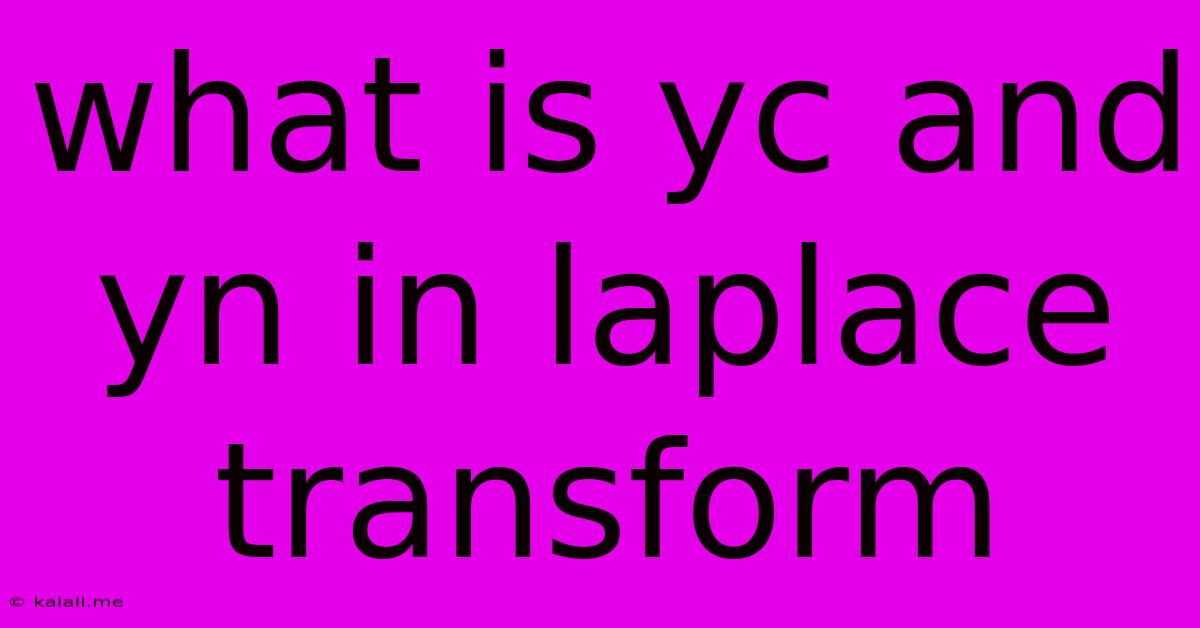What Is Yc And Yn In Laplace Transform
Kalali
May 30, 2025 · 3 min read

Table of Contents
Understanding Yc and Yn in Laplace Transforms: A Comprehensive Guide
This article delves into the concepts of Yc and Yn within the context of Laplace transforms, particularly as they relate to solving differential equations. We'll explore their meanings, how they're derived, and their significance in determining the complete solution to a system's response. Understanding Yc and Yn is crucial for engineers and scientists working with linear time-invariant (LTI) systems.
What are Laplace Transforms?
Before diving into Yc and Yn, let's briefly revisit the core concept. Laplace transforms convert a function of time (often representing a system's behavior) into a function of a complex variable 's'. This transformation simplifies the process of solving complex differential equations, especially those involving systems with initial conditions. The inverse Laplace transform then converts the 's'-domain solution back into the time domain.
The Complete Solution: Yc and Yn
When solving linear differential equations using Laplace transforms, the complete solution often consists of two parts:
-
Yc (Complementary Solution): This represents the natural response of the system. It's determined solely by the system's inherent characteristics (e.g., mass, damping, stiffness in a mechanical system, or resistance, inductance, capacitance in an electrical circuit) and the initial conditions. Yc describes how the system would behave if there were no external forcing function.
-
Yn (Particular Solution): This represents the forced response of the system. It's determined by the external input or forcing function applied to the system. Yn describes how the system responds specifically to this external stimulus.
Derivation and Significance
The derivation of Yc and Yn involves several steps:
-
Taking the Laplace Transform: Transform the given differential equation into the 's'-domain using Laplace transform properties. This often involves terms related to initial conditions.
-
Solving for Y(s): Algebraically manipulate the transformed equation to solve for Y(s), the Laplace transform of the system's output. This will usually be a rational function of 's'.
-
Partial Fraction Decomposition (if necessary): Decompose Y(s) into simpler fractions. This step makes the inverse transformation easier.
-
Inverse Laplace Transform: Apply the inverse Laplace transform to each term derived from the partial fraction decomposition. The inverse Laplace transform of the terms related to the system's characteristics (often poles of the transfer function) contributes to Yc. The inverse Laplace transform of the terms related to the input function contributes to Yn.
Example: A Simple RLC Circuit
Consider a simple RLC circuit. The complete solution, the current i(t), will consist of Yc (natural response, often decaying exponentials reflecting the circuit's energy dissipation) and Yn (forced response, which depends on the voltage source applied). If a sinusoidal voltage is applied, Yn will be a sinusoidal current at the same frequency but potentially with a different amplitude and phase.
In Summary
Yc and Yn provide a powerful framework for understanding the behavior of LTI systems. Yc illuminates the system's natural tendencies based on its intrinsic properties and initial state, while Yn reveals its reaction to external stimuli. Mastering the techniques to find Yc and Yn is essential for analyzing and designing various systems across different engineering disciplines. By understanding these concepts, you can accurately predict and control system response, leading to improved system design and performance.
Latest Posts
Latest Posts
-
On What Day Did God Create Man
May 31, 2025
-
What Is Inside The Ark Of God
May 31, 2025
-
Toilet Water Wont Go Down Not Clogged
May 31, 2025
-
Ac Outside Unit Blowing Cold Air
May 31, 2025
-
Where Are The Speakers On Macbook Pro
May 31, 2025
Related Post
Thank you for visiting our website which covers about What Is Yc And Yn In Laplace Transform . We hope the information provided has been useful to you. Feel free to contact us if you have any questions or need further assistance. See you next time and don't miss to bookmark.